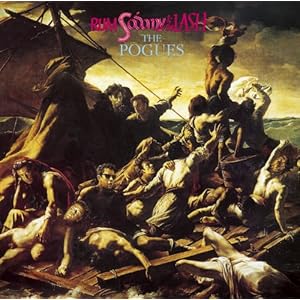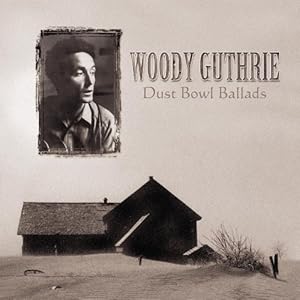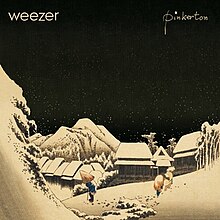O.k., this one may be a little whiny which is the antithesis of rock week, but I love how it builds up at the end, basically matching the singer’s anger. So it’s angry, not whiny.
httpv://www.youtube.com/watch?v=S_aL0v4IXLk
From Seamonsters.
O.k., this one may be a little whiny which is the antithesis of rock week, but I love how it builds up at the end, basically matching the singer’s anger. So it’s angry, not whiny.
httpv://www.youtube.com/watch?v=S_aL0v4IXLk
From Seamonsters.
One of the greatest live acts out there. Believe me with three guitarists, BTS has only one setting: Rock!
From Perfect From Now On
I know everyone was expecting a week of GBV, who knows maybe next time. But of course I have to include some Guided By Voices. Sure their most beloved albums are considered lo-fi classics, but Pollard and Co. can turn up the guitars when they needed to.
httpv://www.youtube.com/watch?v=L5-AFrCnmww
From Vampire on Titus.
So after a week of star fu-- er I mean star grabbing, welcome to Freealonzo’s Rock Week! This week will feature my favorite rock bands rocking out to rock music at its bone-jarring rockingest. No lofi-emo-jazz-acoustic-goth-folk-country-pop-soul music for 7 whole days. Can you handle it? I think you can, in fact I know you can. So get ready to rock because these songs go to 11!!!!!
I think it’s mandatory to start off Freeaolonzo's Rock Week with this song from the Mekons.
httpv://www.youtube.com/watch?v=9q_yT4Rykq4
From The Mekons Rock and Roll
Since I was given this slot by AMR I thought I would take the opportunity to drone on for 28 minutes about GBV…. O.k. maybe not, instead I’ll go all Gleeman on the bit and do some Friday links:
Here’s a well-written commentary from the Curator of the Walker about Low’s 28 minute drone at RTG. Of course he loved it (as did I).
Want to know what the fuss was all about? Here’s the stream:
Har Mar Superstar the Guitar Player for the Replacements? It was fun while it lasted.
One of my least favorite bands are headlining an outdoor show Saturday in Downtown Mpls.
I guess a feminist Taylor Swift twitter account is a thing.
That's all I got. Use the space below and drop some rad lists.
AMR couldn't post the FMD today so I'm filling in. Since he usually kicks things off by talking about new music he's listening to I will take this opportunity to mention that I streamed the new Flaming Lips album The Terror. Didn't do a lot for me -- a lot of space age gobbledygook. Also picked up the new GBV e.p. Down By The Racetrack. It's probably only for completists. On that positive note, hopefully we'll see some rad lists today.

By 1985, punk rock was storming off in all sorts of musical directions. There was proto-punk, country-punk, art-punk, dance-punk, and hardcore-punk. One of the more interesting sub-genres was Irish or Celtic-Punk. Irish Punk was thought of as Irish folk songs or Irish folk-inspired songs revved up to a punk like speed. Locally, the band Boiled in Lead was a fantastic purveyor of traditional Irish music with a punk sensibility. Nationally, however, The Pogues were front in center and Rum, Sodomy & the Lash was the album you had to have if you were into Irish or Punk music.
The Pogues were a perfect Irish band: You had the lead singer, Shane MacGowan - skinny, horrible teeth, hard drinking, gravelly voice; a band with upwards of 7 to 10 members, depending on who was sober or healthy at the time, and a bunch of traditional Irish songs. The album was a blast with songs about drinkin', bleak industrial city living, Jessie James, war, lovers who left, and drinking. The album kicks off with The Sickbed of Cuchulainn an Irish romper sing-along. Dirty Old Town is exactly about what the title says: what it is like living in an old industrial-era city that is crumbling around you. The songs open with the classic line: "I met my love by the gas works wall..." You get the picture.
Other favorites include Sally MacLennane which again is fast, fiesty sing-along. I'm sure this was sung at many going away parties. The highlight of the album is The Band Played Waltzing Matilda which describes an Australian's horrifying experience fighting the Turks in WWI. One of the strongest anti-war songs ever written and it makes me think sadly of our soldiers coming back from Iraq or Afghanistan with broken bodies, never again able to dance.
The album is a fun, singable, danceable ride. The musicians are top notch and the songs are a great combination of old and new Irish songs. A bunch of these songs would be perfect for any party tape, wedding dance, or just to listen to get the blood pumpin'. For that reason Rum, Sodomy & the Lash I consider a classic album. What do you think?

Released in 1940, many consider Woody Guthrie’s Dust Bowl Ballads to the first “concept album.” Listening, it is easy to see why as the name really says it all: Woody Guthrie with guitar and harmonica singing ballads about the dust bowl, it’s just that simple. These aren’t just songs about the Dust Bowl, however. They about the poor sharecroppers, farmers, and family folk impacted by the dust storms of the 1930’s. Through these songs you can see the dust, taste it, smell it, feel it all over your body. The songs are that powerful. The first song (The Great Dust Storm) tells the story. You see that big dust cloud, you learn how the farmers reacted, how scared they were and you can’t believe how bad the storm was, that it could be related to the devastation wrought by a Hurricane Katrina or the wildfires in Colorado Springs.
Dust Bowl Ballads contain songs that are probably familiar to most, even if you don’t know the names or who even sang them: Dusty Old Dust (So Long It’s Been Good To Know You) and Blowin’ Down the Road (I Ain’t Gonna Be Treated That a Way) are so familiar that they’re ingrained in our musical DNA. Pretty Boy Floyd has been covered by so many folk artists, it’s hard to keep count. A musical highlight for me is Do Re Mi, a song about the Okies moving to California and finding out it isn’t the paradise it was advertised as. The fact is that there were so many people moving to California that the local farming communities passed anti-vagrancy ordinances and the Okies had to prove that they either had a job or money (do-re-mi).
Finally one can’t have a song about the Dust Bowl and not mention The Joads. Woody Guthrie loved the movie Grapes of Wrath so much that he wrote a seven minute song (broken into two parts) that basically tells the entire Grapes of Wrath story (with a riff stolen from an older folk song). It’s just as heartbreaking as the book and movie. If you ever need a seven minute refresher of Grapes of Wrath, you may want to check out Tom Joad I and II.
Woody’s voice is quite plaintive but ironically it’s his voice that really gives these songs their texture. The guitar and harmonica are simple, as are the lyrics. But it’s Woody Guthrie’s gift that he could take complex issues and boil them down to their very core. Very few songwriters have been able to do that and to do it over a whole album and it makes Dust Bowl Ballads one of those foundational albums that everyone should have, regardless of your musical tastes.
Supposedly you can stream the album from the Smithsonian here. But I couldn't get it to work.

As Bootsy likes to remind me, Weezer basically sucks these days. Sure they’ll have a decent song here or there (Hashpipe anyone?) but one could argue that they’ve been mailing it in for a while (Hurley…really?). However, Weezer still has a decent fan base, a base built on their first release and ironically enough, it’s follow up, Pinkerton. At its core Pinkerton is basically about love, sex, disillusionment, and relationships. However it is written from the perspective of a young man struggling with fame and its impact on having mature relationships with the opposite sex.
When Pinkerton first came out in 1996 it was considered a big disappointment. Fresh off the heels of the “Blue” album, which included the novelty hit and video Buddy Holly, Weezer’s second album seemed to fall into the sophomore slump category. There wasn’t a quirky hit like Buddy Holly or The Sweater Song and the first released single, El Scorcho, was musically hard to listen, sing along, or dance to. The whole album had a harder edge to it and some of the songs seemed to be in a minor key, which also made it difficult to immediately embrace. In fact Rolling Stone readers voted it the 3rd worse album of 1996. The album’s negative reception was hard on the band (mainly Rivers Coumo) and it took five years for Weezer to get back into the studio.
The love/relationship songs on Pinkerton are written from the perspective of someone immature in handling relationships. As young men, instead of showing vulnerability, we tend to act cocky, acting like it doesn’t matter, that there’s always another chick to conquer. The singer is befuddled, as men usually are when dealing with the opposite sex, but it’s covered by boastfulness. Tired of Sex is a classic example. The song is about how much tail he’s getting and that it’s all soooo boring. He’s both boasting and wanting something more. Getchoo is a song about a guy who has done his girl wrong but now is surprised she’s not coming back. Why Bother takes it one step backward: He knows he’s going to get hurt in the end, why even start the relationship? It’s just not worth it. It’s a tact many young guys take when deciding whether to enter into a relationship or continue to hang with their bros.
Vulnerability does sneak in toward the end of the album. Across the Sea is about a fan in Japan who would be a perfect girlfriend if she didn’t live so far away (plus there are some bonus mother issues thrown in to boot). Pink Triangle is about falling in love with someone who is unavailable (in this case a lesbian). This song contains the classic line “Everyone’s a little queer, why can’t she be a little straight.” Finally in the album’s second to last song the singer finally finds someone he can settle down with. But it’s a little nerve wracking, he doesn’t want to get his heart broke. The last verse really sums it up:
I'm shaking at your touch/I like you way too much/My baby, I'm afraid I'm falling for you/And I'd do about anything to get the hell out alive/Or maybe I would rather settle down with you.
Despite its initial negative reaction, the album has grown in stature over the last 16 years and is now considered a classic and regarded as Weezer’s best album. In 2002, Rolling Stone readers, just six years after saying it was the 3rd worse album of 1996, voted it the 16th best album of all time! Other music publications have placed it in their top albums of the 90’s lists. Unfortunately for their fans, Weezer has not reached the heights suggested by Pinkerton and are more than willing to put out albums of lesser and lesser quality.
What: UEFA Champions League Final
Who: Chelsea (England); Bayern-Munich (Germany)
Where: Allianz Stadium Munich Germany
TV: Fox, Game at 1:45p
Stakes: Bragging rights as top football club in Europe
Today is one of international soccer’s biggest days, probably only behind the World Cup or perhaps the European Cup finals. The Champions League final is this afternoon and if you don’t mind spending a couple of hours inside watching the game, I think you will enjoy it regardless of your soccer knowledge. To give you a little edge if you do decide to watch, here are a few reasons why each team could win. I’ll stay away from the technical aspects but Andrew, Pirate, Homer Dome or others feel free to chime in through the comments. If you want a technical review, this one is pretty good.
Continue reading Champions Leage Final: Chelsea v. Bayern-Munich